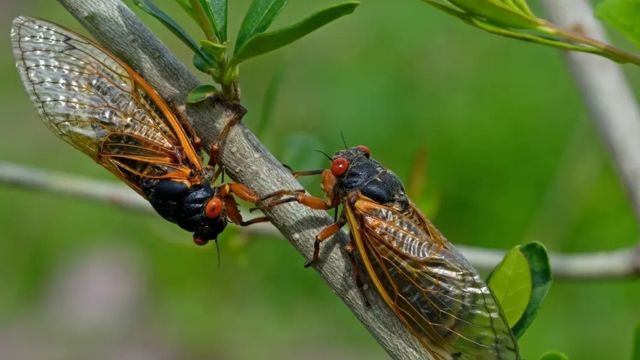This spring marks a momentous event in the natural world that spans across 16 states in the Midwest and Southeast of the United States: a dual emergence of two periodical cicada broods, Brood XIX (the Great Southern Brood) and Brood XIII (the Northern Illinois Brood), not witnessed together since 1803.
This extraordinary occurrence, unfolding for the first time in centuries, is a testament to the wonder of nature’s cycles and the enduring mysteries of its inhabitants.
With an expected count reaching up to a trillion, these cicadas will blanket forested and urban green spaces, significantly outnumbering their annual counterparts.
The sheer volume of these insects is staggering, with Floyd W. Shockley, an entomologist at the Smithsonian National Museum of Natural History, noting that a line of a trillion cicadas end to end would traverse to the moon and back 33 times.
The timing of their appearance is dictated by temperature, with the first cicadas emerging in late April as the soil warms to 64 degrees Fahrenheit. Their arrival is anticipated following a soaking rain, facilitating their dramatic emergence from the earth and the commencement of their mating rituals.
The buzzing chorus of male cicadas, seeking mates, is a natural phenomenon, creating a cacophony that rivals the loudness of a plane.
This natural spectacle will span from northern Louisiana through to eastern Iowa, touching upon diverse landscapes and ecosystems. While urban areas may face challenges with the sheer number of cicadas, these insects are not harmful to humans or pets; they do not bite or sting, nor do they transmit diseases.
However, their presence in large numbers on sidewalks and streets may necessitate clean-up efforts to prevent slippery conditions.
The ecological impact of the cicadas is overwhelmingly positive. Their emergence from the ground provides aeration for the soil and nourishment for tree roots during the summer months. The natural pruning process, or “flagging,” caused by the cicadas, results in larger fruit yields from trees. And as their life cycle concludes, the nutrients from their decaying bodies enrich the soil, fostering a healthy ecosystem.
Given the cicadas’ beneficial role, experts advise against any attempts to eradicate them. Protective netting is recommended for safeguarding delicate plants, but broad use of insecticides could harm other wildlife and should be avoided.
Emphasizing the cicadas’ integral role in the ecosystem, John R. Cooley, a biology professor at the University of Connecticut, urges residents to appreciate and coexist with these remarkable insects.
This dual emergence of cicadas invites us to marvel at the intricacies of nature and the cycles that have persisted through millennia. As communities across the Midwest and Southeast prepare to experience this historic event, it serves as a reminder of the resilience of life and the importance of ecological stewardship.
For six weeks, the air will be filled with the sounds of a grand natural symphony, a rare and fleeting reminder of the planet’s wonders that lie just beneath our feet.

